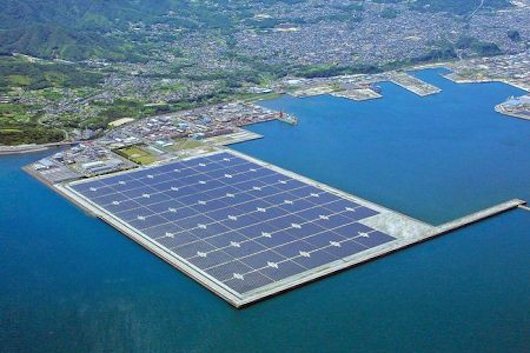Solar panels are quickly becoming a familiar sight on rooftops. As this efficient form of renewable and sustainable energy increases in popularity, we may begin seeing them floating on reservoirs. Continue reading to learn about the first floating solar farm in the UK!
The UK’s first fully operational floating solar project has been constructed and successfully launched in Berkshire, in a design that its developer reveals will act as a blueprint for the technology to be installed at hundreds of sites across the United Kingdom.
The panel system is based at Sheeplands farm in Berkshire, and consists of 800 solar panels. It was established in early September on an irrigation reservoir of 300-acres and features 200kW of solar PV panels.
According to reports, the scheme is considered eligible for renewable energy subsidies, financed by energy bill payers.
Mark Bennett, the CEO and developer of the project, told the Telegraph that the floating panels produce more revenue than solar farms on fields because earnings from potentially valuable farmland have to be sacrificed to make space for them. He told the reporter about his strong interest in this technology and supporting its use elsewhere.
He said:
“The launch of our new installation signals what we hope is a revolutionary new alternative for owners of large used, and unused, bodies of water who are wanting to generate both renewable energy and sustainable income.
The technology is durable, cost effective and so flexible that it only took us a week to install a 200kW system with over 800 floating panels.”
The French firm “Ciel et Terre” is the company that developed the technology with Mr. Bennett’s newly-established company, Floating Solar UK. Floating Solar UK is the first official and approved distributor of the technology in the UK, after it was tested in Japan.
Alexis Gaveau, the president of Ciel et Terre described:
“It is fantastic to see our innovative technology now being deployed in the UK for the first time. The floating solar installation at the Sheeplands Farm site is a real-world example of how advancements in renewable technology can both easily be installed and deliver results so quickly.”
Minimum Profit: £620,000 Over The Next 20 Years
This project was installed at a cost of £250,000 and it can generate up to 200 kilowatts of power. Mr Bennett estimated that the panel system will earn him at least £620,000 over the next 20 years. He is expected to be a part of even bigger projects in the future, while will also save about £24,000, because there’s no need to depend on the National grid.
He said:
“We are speaking to big utility companies, to agricultural companies – anyone with an unused body of water. The potential is remarkable.”
The director of the Renewable Energy Foundation, John Constable, said:
“Floating solar panels seemed to be an incredibly lucrative way of getting subsidies. When subsidies are committed to the market, all sorts of strange things happen.”
In the same time, the policy and campaign director at the Campaign to Protect Rural England, Neil Sinden, told the Telegraph:
“We welcome alternative sources of green energy, but any potential solar development should meet certain planning criteria – whether on land or on water.
Visual impact on the landscape, as well as biodiversity and tranquility, are all important considerations, both with the solar panels themselves and associated infrastructure such as grid connections and substations.”
The Benefits of This Project
RE News reported that according to the company which led the project, that it will mainly be used to supply the pump that sends water from the reservoir with electricity, plus many other aids including:
- Getting higher electricity production.
- Return on investment raised from the low lease price and construction cost.
- Raise the lifecycle of a reservoir by curbing the formation of erosion.
- Preservation of environment and farming lands.
- Decreasing the evaporation of water which means saving more for irrigation and drinking.
- Controlling the growth of algae.
- Saving parts of nature and the environment.
IEA: Solar Power ay Become the Main Source of Electricity by 2050
According to a report by the International Energy Agency (IEA), solar power may become the main source of electricity by 2050, especially taking into consideration the relatively low cost of the equipment needed to generate it.

The IEA has said that solar photovoltaic (PV) systems could produce up to 16% of the world’s electricity by 2050, as the world has added more PV capacity since 2010.
The IEA Executive Director, Maria van der Hoeven, told Reuters:
“The rapid cost decrease of photovoltaic modules and systems in the last few years has opened new perspectives for using solar energy as a major source of electricity in the coming years and decades.”
Sources:
1. Britain’s first floating solar panel project installed
2. Floating solar first for UK
3. Solar could be world’s top electricity source by 2050 – IEA
Originally posted on Collective-Evolution.com
Do you recognize this image? We’d love to provide proper attribution!





No Comments